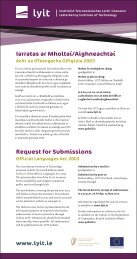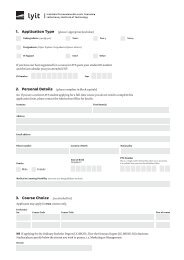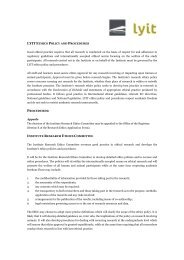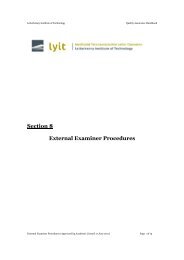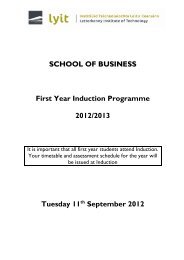Scoping Study Final Report.. - Letterkenny Institute of Technology
Scoping Study Final Report.. - Letterkenny Institute of Technology
Scoping Study Final Report.. - Letterkenny Institute of Technology
You also want an ePaper? Increase the reach of your titles
YUMPU automatically turns print PDFs into web optimized ePapers that Google loves.
North West Gateway Strategic Alliance (NWGSA) <strong>Scoping</strong> <strong>Study</strong>4. The population <strong>of</strong> the linked <strong>Letterkenny</strong>-Derry Gateway amounted to 125,490persons in 2006. Outside the major urban areas <strong>of</strong> Dublin, Belfast and Cork, the<strong>Letterkenny</strong>-Derry Gateway has the largest population base among the 14gateway cities/towns in RoI and is one <strong>of</strong> the largest inter-urban areas in theisland <strong>of</strong> Ireland.5. With a population <strong>of</strong> 17,586 persons in 2006, <strong>Letterkenny</strong> enjoyed the fastestgrowth in population out <strong>of</strong> the 11 cities and towns in RoI with a HEI since 2002(15% growth cumulatively or 3.7% per annum on average during 2002-2006).6. The proportion <strong>of</strong> the population in the 0-14 year age cohort is relatively high inthe NWGSA Region compared with RoI and NI, suggesting a comparatively high‘latent’ demand for HE in the region for the next few years.7. However, during the past decade (1996-2006), there was no growth in thenumber <strong>of</strong> residents in the NWGSA Region aged 15-24 years and the number <strong>of</strong>people in this age category fell by 0.6% per annum in Donegal.8. Projections for population developed by Indecon/London Economics (based on<strong>of</strong>ficial population forecasts in NI and RoI) suggest the following outcomes interms <strong>of</strong> the likely pattern <strong>of</strong> prospective demand for HE in the NWGSA Regionover the medium- to long-term (until 2021):i. A likely driver <strong>of</strong> the growth in HE demand in the NWGSA Region willbe from the 25+ age cohort. This relates to ‘non-traditional’ students andlifelong learners, including people seeking to enhance or differentiatetheir skills;ii. Across the NWGSA Region, the absolute and relative population in the‘traditional’ new entrant (15-24 years) cohort is expected to decline andthis may lead to a decline in HE demand among this group (although notnecessarily so in the event that a greater proportion <strong>of</strong> the persons agedbetween 15 and 24 years enrol on HE courses, which may be likely) –thus, it is not necessarily correct to say that there will be a decline in thetraditional segment <strong>of</strong> the HE intake in the NWGSA Region over thecoming years.9. Despite the gains in student enrolments achieved by LYIT and Ulster in theNWGSA Region in recent years, the level <strong>of</strong> higher educational attainment(among residents) is relatively low in the NWGSA Region: in the NI part <strong>of</strong> theRegion, 17% <strong>of</strong> the working age population had a primary degree or higher in2006 compared with 23% in NI as a whole; in the Donegal part <strong>of</strong> the NWGSARegion, 12.5% <strong>of</strong> persons aged 15+ years had a primary degree or higherqualification in 2006 compared with 18.5% for RoI. These facts are likely toreflect the structure <strong>of</strong> economic activity and employment in the region.Indecon and London Economics March 2009 Page 7



